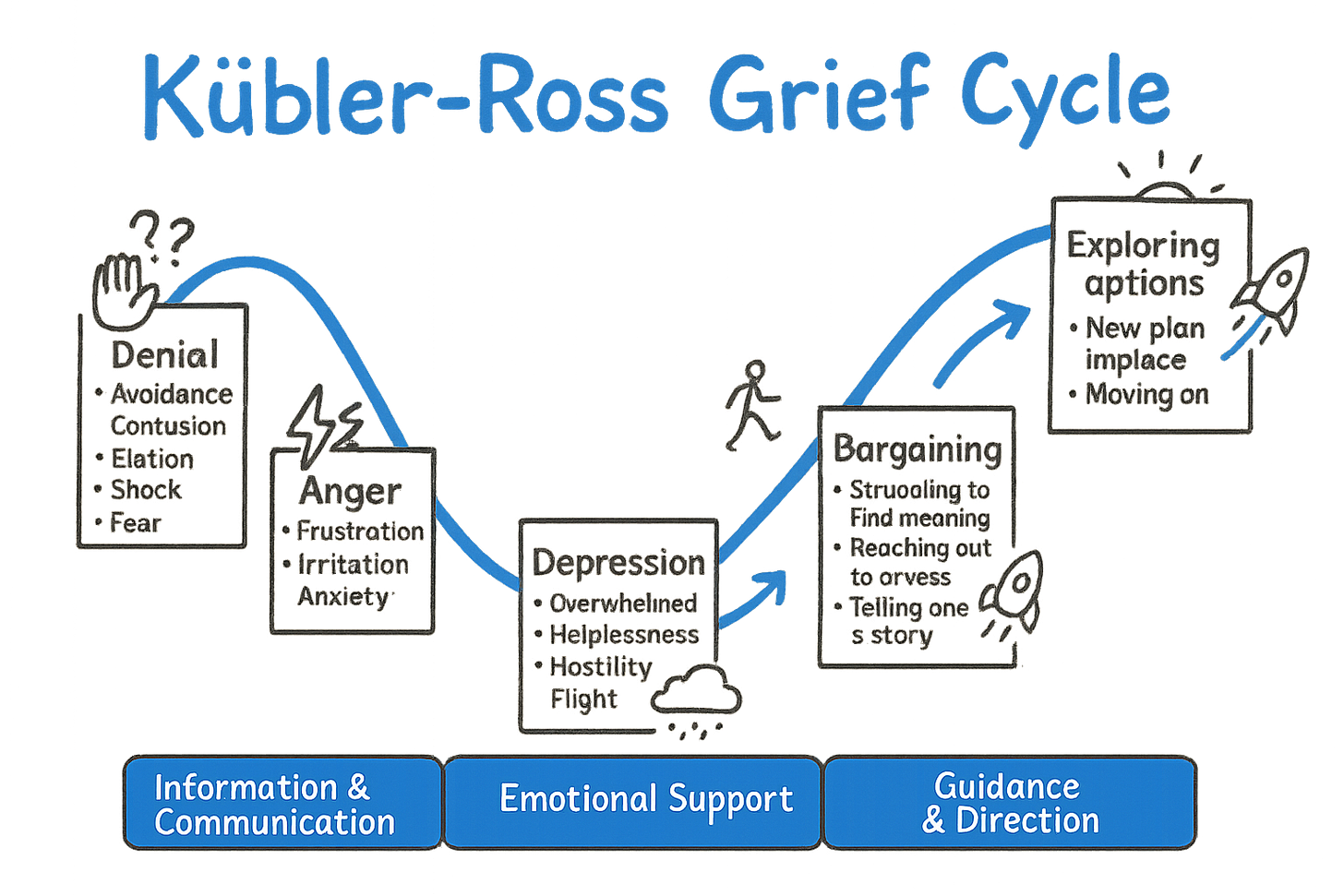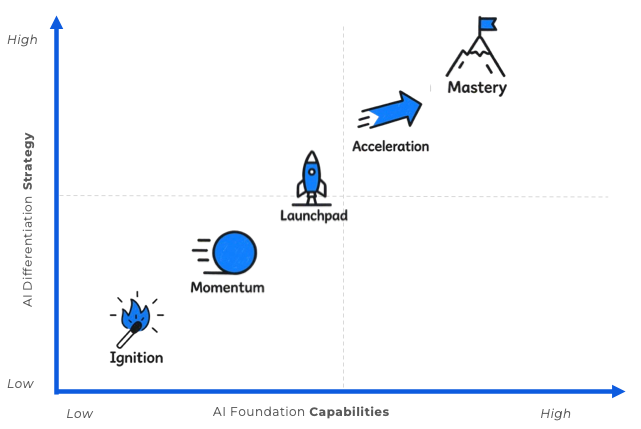From AI-Enabled to AI-First: Why Capability + Strategy Decide Who Wins
Three years into the age of generative AI, the picture is puzzling.
Models are smarter, faster, and cheaper than ever before. Stanford’s 2025 AI Index shows adoption jumping from 55% to 78% of companies in just one year. Bain’s 2025 report finds that in sales, organizations that reimagine the process (not just automate it) can see win-rate improvements above 30%. Meanwhile, BCG’s “Widening AI Value Gap” analysis shows that future-built firms (i.e. true AI-first operators) achieve on average 5× revenue growth and 3× cost reduction compared to laggards.
And yet, most organizations aren’t reaping the benefits. Accenture’s survey of 1,200 firms found two-thirds stuck in “experimentation mode.” They dabble with pilots and vendor demos, but few see transformation at scale.
Why? The answer is not the technology. It’s the organization.
Enabled vs. First: A Crucial Distinction
Many companies today are AI-enabled: they add AI tools into existing processes. Think of sales teams using AI to draft emails, or HR managers relying on AI for resume screening. These are useful, but incremental.
By contrast, AI-first companies design their workflows, roles, and even business models around AI from the start. They don’t just add tools, they rewire the operating model.
Klarna, for example, shifted customer support from large call centers to an AI-driven service backbone, cutting human agents dramatically while speeding up service. Octopus Energy redesigned its grid management using AI, matching renewable supply with household demand in real time. These aren’t add-ons, they are structural redesigns.
The distinction matters. Enabled firms see efficiency. First firms build advantage.
Why Most Get Stuck
Recent research shows why so many transformations stall in the messy middle:
Skills without strategy: Teams experiment, but their wins don’t scale.
Strategy without skills: Leaders write bold roadmaps, but execution falters.
Both missing: The company drifts, watching competitors pull ahead.
Consider the European conglomerate that invested €20M in AI only to shelve the program a year later. The models worked, but employees lacked basic prompting skills, data was siloed, workflows hadn’t been rethought, and leadership never tied projects to strategic goals. The result? A graveyard of impressive demos with no business value.
This is the pattern: capability gaps below, strategy gaps above. Without both, progress stalls.
The Two Dimensions That Matter
Think of AI transformation as a simple equation:
AI Capability × AI Strategy = AI Advantage
Capabilities: what your people and teams can actually do with AI.
Prompting and tool fluency.
Responsible use (data, bias, governance basics).
Data readiness and workflow redesign.
Building co-intelligence - humans and AI collaborating, not competing.
Strategy: how those capabilities are directed to create sustained value.
Where do we play? (efficiency vs. differentiation; internal vs. customer-facing)
How do we win? (cost advantage, customer intimacy, new products)
What guardrails keep us safe? (governance, risk, ethics)
How do we measure progress? (KPIs, scorecards, feedback loops)
When one side is missing, the other collapses. Together, they create momentum that moves a company from experimentation to transformation.
Horizons of Value
What does success look like? AI advantage typically unfolds in three horizons:
Cost Efficiency: Weeks saved, faster response times, lower customer acquisition costs. Walmart’s demand forecasting cuts waste and stockouts.
Revenue Optimization: Smarter personalization, pricing, and retention. Netflix reports that 75–80% of what users watch comes from AI-driven recommendations.
New Revenue Growth: Entirely new products, services, and models. Duolingo built an AI-tutor experience that boosted daily active users by 51% and unlocked fresh revenue streams.
Most companies stop at the first horizon. AI-first firms move through all three.
The Path from Pilots to Advantage
Every major transformation comes with turbulence. Psychologists Elisabeth Kübler-Ross and David Kessler famously described the five stages of grief: denial, anger, bargaining, depression, and acceptance. While originally applied to personal loss, this curve has been widely used to understand organizational change.
When AI enters the workplace, the same pattern often plays out:
Denial: “This won’t affect us. It’s just hype.”
Anger: “This is disruptive, it threatens my role.”
Bargaining: “Can’t we just use it in small pilots and keep everything else the same?”
Depression: “The old way isn’t working anymore, but the new way feels overwhelming.”
Acceptance: “This is the future. How do we make it work for us?”
The challenge for leaders is not to eliminate these stages, but to help the organization move through them faster and with less friction. Each stage requires different tactics: awareness campaigns, training, safe experimentation, role-modeling from leaders, and visible early wins.
That’s why moving from pilots to advantage is not just about technology deployment, it’s about navigating the emotional and cultural curve of change.
Ignition: Kickstart with safe, contained use cases. Give broad access to tools, encourage experimentation, remove bureaucratic blockers.
Example: Shopify gave employees credits to try different AI tools, signaling that “AI is not optional, it’s the future.”Momentum: Capture quick wins and share them. Create internal communities where employees swap prompts, agents, and lessons.
Example: Duolingo rewarded employees who shared AI hacks that improved both internal productivity and customer experience.Launchpad: Prioritize high-value workflows and integrate AI deeply. Shift from experimenting in the corner to embedding in core processes.
Example: Zapier built automated sales lead workflows that reshaped how entire teams operated.Acceleration: Scale systematically. Embed AI into KPIs and performance metrics, clear legal and IT bottlenecks, and provide advanced training.
Mastery: Sustain the advantage. AI becomes part of culture, strategy, and continuous renewal. Companies track not just cost savings, but new value creation.
This progression is not linear, but the direction is clear: start somewhere, but move deliberately.
Risks and Guardrails
Being AI-first is not about reckless speed. The Air Canada chatbot case - where a bot promised fares the airline couldn’t honor, and the company was held liable - shows why governance is non-negotiable.
The Leadership Paradox is this: you must move fast enough to capture opportunities, while building the guardrails that protect trust, ethics, and compliance. Neglect either side, and the transformation fails.
The Call to Leaders
Here’s the takeaway:
Don’t stop at being AI-enabled. That’s the starting point, not the finish line.
Build both muscles. Skills without strategy is speed without direction. Strategy without skills is vision without traction.
Aim for advantage, not demos. Efficiency gains are useful, but the real prize is reimagining how your company creates value.
If you are a CEO, ask yourself and your team today:
Do we know what our people can actually do with AI?
Do we have a clear aspiration for how AI reshapes our business model?
Are we measuring progress across both dimensions?
The organizations that win in this era will not be those with the flashiest pilots, but those that combine capabilities and strategy into an AI-first operating model.
How I Can Help
I’ve had the privilege of working with organizations such as DryDocks World, UAE Ministry of Foreign Affairs, Omantel, Ooredoo, among others to guide their leaders and teams through these exact stages of AI adoption. From building foundational fluency to embedding AI in workflows and strategy, I’ve developed structured programs that help organizations move from experimentation to transformation with confidence.
Through my executive workshops, capability-building programs, and strategic frameworks, I support CEOs and leadership teams in navigating the change curve, so AI adoption doesn’t stall at pilots but translates into lasting competitive advantage.
If your organization is at the crossroads of being AI-enabled and becoming AI-first, let’s explore how we can make the journey deliberate, structured, and successful.
To learn more, visit renebohnsack.com or reach out directly at rene@cerenety.com
The future won’t wait. Why should you?



